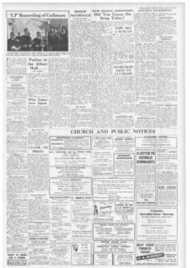Page 10, 7th March 1958
Page 10

Report an error
Noticed an error on this page?If you've noticed an error in this article please click here to report it.
Tags
Share
Related articles
The Pope On Cinerama
At The Cinema * * * * * -* * * *. * *
New In Tiie Cinema
At Tie E Cin E111 A ■ Miss Bardot Can Act After All..
▪ Despite All This Bing Wins
Look, but don't Listen I
'GRACE CONW
Looks at the Films
Seven Wonders of the World Certificate U: Casino Lowell Thomas Production
CO many hard things have been L.) said about the commentary in this latest Cinerama show that I don't propose to add anything. lit any case, I have long been hardened in the matter of American commentaries.
I think the crisis occurred during the war. I had been seeing one of those travelogues about the South Sea Islands Bali in particular.
I came out into the Strand with the words ringing in my ear: "And so we bid goodbye to beautiful Bali one of the last peaceful spots in this world today." The first thing I saw was a poster saying "Bali Bombed".
Since then I rarely listen to commentaries, and so in this new and exciting trip round the world I looked and did my best not to listen.
And what a lot there is to look at, beginning with the runway being flown over at a speed that recalls the sensation experienced on the giant racer, as the plane takes off with us in there with the giant camera fixed right in the nose of the plane.
To carp at the commentary is, I think, not to be able to see the wood for the trees. 1or it is what we sec that matters here.
Altogether there were five directors: Ted' Tetzlaff for the Holy Land and Rome; Tay Garnett for India, the Taj Mahal and the train that runs backward (taking us with it) down the Darjeeling track; Paul Mantz for the American sequences; Andrew Martin for Arabia, Greece and Egypt; and Walter Thompson for Japan.
In my briet note last week, I singled out the Vatican and Castel Gandolfo sequences for special mention, because for this section alone I should think all Catholics who can will want to go to "Seven Wonders of the World".
You might be kneeling at the Holy Father's feet to receive that triple bleSsing a close-up that not even those standing in the front row of the pilgrims underneath the balcony could have had,
Then again, those wonderful shots of the procession at the closing ceremonies of the Marian Year inside and outside St. Peter's are a piece of valuable pictorial history that only seldom comes our way.
The plane flies slowly over the Holy Land Bethlehem, Nazareth, the Mount of Olives, along the Via Dolorosa, on to Mount Golgotha a miniature Lenten pilgrimage. In neither this part nor in the Vatican sequences does the commentary offend.
Only the Japanese section made me want to take my eyes off the screen too many magenta-clad ladies waving fans in the ornamental gardens. The Silent Enemy Certificate U: Odeon, Leicester Square Director: William Fairchild
ST1LL they come the tales of
heroism. initiative. improvisation, individual effort that won World War II. And there is no more intriguing bit of war history than the work of Lieutenant Crabb, R.N.V.R.. who defeated the ingenuity of the Italian underwater crews bent on sinking the North African invasion fleet in 1941.
Crabb (incidentally he was a convert to Catholicism. which explains his making the sign of the Cross and reciting the De Prof undis over the body of an Italian engineer) was an expert in bomb disposal. When he went out to Gibraltar the Royal Navy was being harassed by the activities of the Italian frogmen operating from nearby Algeciras unknown to the neutral Spaniards.
Up to that point, the only crew of British frogmen trying to cope with this situation numbered two. Crabb made a third.
The toll of sunk ships right there in full view of R.N. Gibraltar headquarters continued to be heavy until Crabb made his most daring sortie right into Algeciras itself, where he discovered the fantastic source of the " chariots " -two-manned under-water carriers that took the mines and stuck them on to the hulls of our ships.
Looking and sounding rather like a youthful edition of Mr. Robertson Justice, Lawrence Harvey, his silky fair hair waving like some exotic species of seaweed beneath the waves, does extremely well in the part of Crabb -an agreeable mixture of the man of action, of Nelson-like doggedness, with a disregard of official obedience when he thought he knew better and of the charm which made Crabb the good cornpanion everybody said he was.
In support, in this absorbing and consistently suspenseful film. are Michael Craig, Alec McGowen, John Clements (tight lipped Admiral), and Sidney James (chief petty officer in charge of discipline and getting some wry fun out of it).
the film ends with the award of the George Cross to this brave man. Of his mysterious death in 1956 we do not hear. That is no doubt reserved for a further chapter which I don't suppose we will read for a very long time.
The Safecracker Certificate U: Empire
Director: Ray Milland wAR again on land with Ray
Milland directing himself in what I understand is based on a true episode. A firm of safemakers employs one Colley Dawson (Ray Milland) an expert on locks. Later he comes under the influence of a dishonest antique dealer (Barry Jones) and together they collect some rare pieces until he lands in prison.
Thence he is prised out to crack a safe in occupied Belgium that contains the names of all the German spies in wartime London.
The raid is well staged, and the denouement not what we generally expect on the screen.
blog comments powered by Disqus











